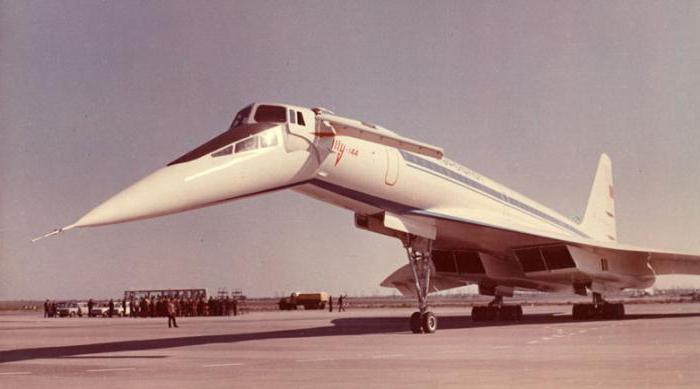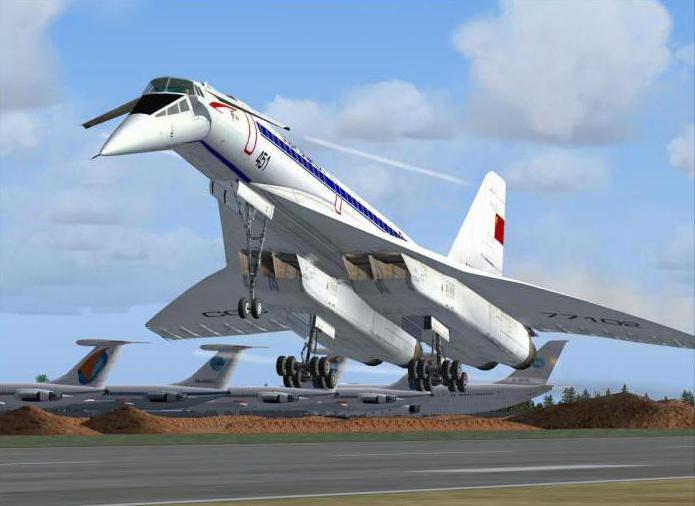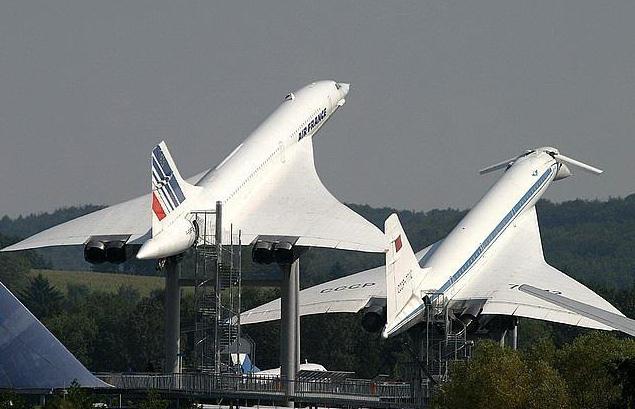The supersonic passenger airliner Tu-144 was created in the Soviet Union in the late 1970s. It was launched into the series, and for some time was used for the commercial transport of passengers. Great hopes were pinned on the Tu-144 in the USSR - it had to first unite all the regions of a huge country, and then go beyond its borders. Unfortunately, this never happened. Today we will look at the history and characteristics of the Tu-144, why this machine was decommissioned, and how it differs from competitors.
Summary
Undoubtedly, the Tu-144 is a legendary and unique aircraft. He became the first passenger aircraft, the speed of which exceeded the speed of sound. Simultaneously with the Tu-144, the characteristics of which we will consider below, the engineers of England and France jointly created another jet supersonic passenger airliner - the legendary Concord. It's no secret that the development of these machines was another Cold War event. The project of Soviet designers from a technical point of view was not inferior to the project of their competitors, however, it was losing economically.

Flying on a supersonic plane was expensive, and in the Soviet Union there were few people who could afford it, so tickets did not cover all the costs of fuel and maintenance of a jet plane. The Western passenger was ready to pay for the flight speed and a high level of comfort, so the Concordes were recognized as a successful project, which can not be said about the Tu-144. Why was this aircraft decommissioned? One of the most important reasons was economic inexpediency.
As a passenger airliner, Tu-144 was used for less than a year. Then it began to be used for testing and transporting urgent goods over long distances. During operation, the aircraft managed to carry only 3,284 passengers. Its main competitor transported a total of 2.4 million passengers. A total of 16 aircraft were issued. It is worth noting that the Concordes released only 4 cars more. In 1999, the last flight of the Tu-144 aircraft took place. Despite the dubious reputation, the Soviet aircraft managed to set 13 world records.
Background
The 1950s and 1960s of the twentieth century were marked by the rapid development of jet aircraft. It all started with the fact that in 1947, the experimental American aircraft Bell X-1 overcame the sound barrier. In the mid-sixties, America began serial production of supersonic fighters. And by the mid-seventies, the technology for creating such machines was already run-in, and engineers seriously thought about the prospect of creating supersonic passenger aircraft. At that time, it was a dictate of the time. The use of such machines was beneficial for airlines for at least two reasons: reduced flight time, lack of need for intermediate landings for refueling.
Creating passenger supersonic airliners was not so simple. After carefully weighing everything, American designers abandoned this venture, recognizing it as inappropriate. The Europeans still decided to test in practice the prospects of supersonic passenger technology. The development of such an aircraft at the same time engaged the French and the British. In 1962, they joined forces. So the project of the Concord aircraft appeared. The Soviet Union was also interested in this idea. And the fact that the Europeans did not hide their designs and actively demonstrated them at international air shows, allowed domestic designers to cut off a number of incorrect decisions even before the start of the project.

In the Soviet Union, the creation of a supersonic passenger aircraft was entrusted to Tupolev Design Bureau. The specialists of this organization were the most experienced in the creation of jet aircraft. In addition, it was the Tupolev Design Bureau that was the first in the USSR to create a supersonic aircraft - the Tu-22 bomber.
Development
In 1963, the history of the creation of the Tu-144 began. The Council of Ministers of the USSR ordered the development of a passenger liner with the following parameters:
- Flight range - 4000-4500 km.
- Cruising speed - 2300-2700 km / h.
- Passenger capacity - 80-100 people.
The very next, 1964, the development of a new aircraft began. And a year later, the layout of the car was presented at the international exhibition in Le Bourget. According to Tupolev, the plane was supposed to fly into the sky two months earlier than the Concord. In the end, it happened.
While working on a fundamentally new aircraft, designers faced a number of problems, in particular, with the unusual aerodynamics of the body and heating of its body, followed by deformation at high speeds. The development of a wing of a suitable design was especially delayed, during which about two hundred variants were tested in a wind tunnel.
When developing the Tupolev aircraft, the MiG-21 became the current model. However, its design was somewhat modified: the horizontal tail was removed, the length of the fuselage was reduced, and the wingspan was increased. December 31, 1968 Tu-144 first flew. This happened just two months before the first flight of the Concord. The following year, the aircraft reached the speed of sound, and a year later it exceeded it twice.
When a supersonic passenger plane appeared in the USSR, the whole world started talking about it. In 1971, the airliner made several test flights, visiting Moscow, Sofia, Berlin and Paris. In the same period, Aeroflot began the experimental operation of the Tu-144. Serial production of the machine was established at the Voronezh plant.
Design
The Tu-144 is an all-metal monoplane, which is characterized by a low wing position and is the embodiment of the “tailless” design scheme. Its fuselage is made in the form of a semi-monocoque, the lining of which is based on stringers and frames. The aircraft is equipped with a three-leg landing gear and nose strut.
The power plant of the airliner is represented by four engines of the turbojet engine model NK-114A or RD-36-51A, which are located in pairs. Each of the motors is equipped with its own air intake. Engine nozzles protrude beyond the wing edge.
The fuselage of the aircraft is conventionally divided into the bow, center and tail. The cockpit is located in the bow, the lantern of which fits into the nose fairing and the fuselage contours. The central part is represented by passenger interiors, which form a single unit with the bow. In the rear part there is a caisson tank for fuel, and in its tip - a container for the brake parachute.
The wing of the aircraft received a variable sweep. In the root part of the wing, it was 76, and at its ends - 57 degrees. The wing was trimmed with a special alloy, which is based on aluminum. Elevons located on the back of the wing are made of titanium alloy.
To improve visibility during takeoff and landing, the aircraft cabin could be lowered. Its raising and lowering was carried out thanks to the hydraulic drive. 18 fuel tanks were located in the wings of the aircraft. In addition, a special balancing tank was installed in the rear of the fuselage. He received fuel during the transition of the aircraft from subsonic flight mode to supersonic. The front landing gear of the aircraft had two wheels, and the two main struts had four twin carts.
The control of the aircraft was carried out using an onboard electronic computer. The approach could be made at any time of the day, in any meteorological conditions. Automation diagnosed the operation of all on-board systems, which was a real novelty for the domestic aircraft industry. The crew consisted of three people. Depending on the version of the aircraft, its passenger capacity could vary from 98 to 150 people.
The front horizontal tail unit has become an interesting feature of the Tu-144 aircraft, distinguishing it from other machines. It is located immediately behind the cockpit, in front of the aircraft. Thanks to this plumage, the aircraft received increased maneuverability and additional lift. In addition, the horizontal tail allowed the machine to reduce speed faster at the time of landing and use shorter runways.
First disaster
The most significant and tragic day in the history of the Tu-144 aircraft was June 3, 1973, when the first Tu-144 crashed during a demonstration flight in Le Bourget. About 350 thousand spectators watched the tragedy. The crash killed five crew members and residents of the town of Hussenville (France), near which the air show was held. In addition, nearly three dozen people were injured.
The crew of the Soviet aircraft wanted to fly over the runway and regain altitude. The day before, this maneuver was demonstrated by the Anglo-French Concord. But it was not possible to carry out the plan. Suddenly, the plane began to dive, and having descended to a height of 120 meters, it simply began to fly apart. First, a wing detached from the hull, and then the tail. In a matter of seconds, only a pile of metal remained from the plane.
The reasons for the terrible disaster to this day are unclear. According to one version, the Tu-144 crew was forced to sharply maneuver in order not to collide with a fighter who took pictures of the air show participants. There is another version, according to which the airliner refused control system. Many years after the tragedy, one of the representatives of the Tupolev Design Bureau told reporters that on that version of the Tu-144 there were a number of untested blocks. Another version indicates that when performing the maneuver, one of the pilots dropped a movie camera that blocked the steering column, but the flight recorders did not confirm this.
The official report indicated that the disaster could have been caused by the fall of a crew member in the cockpit, but no material evidence was found. In the end, the causes of the disaster were called unidentified. The dead crew members were buried at the Novodevichy cemetery.
Exploitation
Despite the terrible crash of the Tu-144, Le Bourget saw him twice more, in 1975 and 1977. When Brezhnev went on an official visit to France in 1977, he was shown the Concord of the latest development. At that time, the Anglo-French car carried out international and intercontinental flights. Returning to the USSR, Brezhnev ordered the Tu-144 to be put into commercial operation as soon as possible.
A little earlier, work was launched to increase the flight range of the airliner. Tu-144 equipped with new, more economical engines model RD-36-51A. This modification is called Tu-144D. December 26, 1975 passenger Tu-144 made its first flight from Moscow to Alma-Ata. To begin with, he was instructed to transport mail. The flight was successful, and at the end of 1977 passenger traffic began on the Tu-144. Management of a supersonic airliner was trusted only to the most experienced pilots. Previously, they underwent special training. In addition, the Tu-144 chose the most beautiful stewardesses.
Two airplanes equipped with NK-144A engines flew along the Moscow-Alma-Ata route. Such a power plant allowed the aircraft to fly no more than three thousand kilometers. The fuel supply was barely enough for the aircraft to reach its final destination. If, in the event of an emergency, the plane couldn’t land at the airport of Almaty or the emergency runway in Tashkent, there would be no place to land it. Thus, each flight became for pilots and their superiors a real test of strength. A ticket for the Tu-144 cost 80 rubles, which is 18 rubles more expensive than a ticket for a regular plane.
The Soviet leadership had a serious plan for the Tu-144. They wanted to launch the Tu-144D version on the route Moscow - Khabarovsk, and then open international flights for it. However, the plan never came true.
Another crash of Tu-144
On May 23, 1978, the Tu-144D experimental plane crashed. This time, the cause of the accident was the ignition of the third engine and the smoke of the cabin caused by the destruction of the fuel line. When the malfunction made itself felt, the crew resorted to an emergency landing. After landing, the pilots hastened to leave the plane, but the two flight engineers did not have time to do so.
At the end of July 1980, another accident occurred with the Tu-144D aircraft, which almost led to a tragedy. At supersonic speed, one of the engines collapsed. The professional crew managed to land the plane, and the engines were sent for revision. During subsequent tests, they worked problematically. When Brezhnev died, the project of a supersonic airliner was left to chance, as the new government was skeptical of him. In the end, the country's leadership decided to close it and continue passenger transportation with simple and economical subsonic aircraft.
For some time, the supersonic Tu-144 was used to conduct test flights and deliver urgent cargoes. Pilots who participated in the program of the Soviet shuttle Buran trained on it. Soon, everyone began to forget about the Tu-144.
Why was the aircraft decommissioned?
Even for the USSR, where they did not like to count money, the operation of a supersonic airliner became too expensive and, most importantly, meaningless. Therefore, the main reason for the cessation of the development of the project was not the Tu-144 disasters and technical problems, but the lack of economic profitability.
With old power plants, the flight range of the aircraft did not exceed 3 thousand kilometers. Given the liner's belonging to supersonic, this is negligible. To carry out long trips, the aircraft needed to make intermediate landings for refueling, which nullified all its strengths. The goal of the project was to make fast flights between remote cities without transfers and refueling. The range of the Concord, for example, reached 6500 km. The RD-36-51A engine could allow the Tu-144 to fly at a distance of about 5300 km, but all the problems associated with it have not been resolved.
In addition, the price of tickets for the Tu-144 was far from the amount necessary to recoup all the costs of flights and aircraft maintenance. The USSR leadership did not want to take more money from citizens for a ticket, and it is unlikely that ordinary people would begin to overpay for flight speed. Therefore, a supersonic passenger airliner went down in history no more than as evidence of the high level of Soviet aircraft designers. However, the Tu-144 catastrophes somewhat undermined their reputation.
Research lab
In the mid-2000s, the Tu-144 aircraft, the characteristics of which we have already examined, took part in a research program conducted by the Tupolev Design Bureau together with American aircraft designers. As part of the program, NASA has explored the prospects of creating a new generation of supersonic airliners.
The Tu-144LL model, which is an upgraded version of the Tu-144D aircraft, took part in the program. The main difference between the updated aircraft and its predecessor was the new power plant model NK-32-1, replacing the obsolete RD-36-51D engine.
American engineers were mainly interested in issues related to flying at supersonic speeds: the temperature of metal parts and casing, the operation of engines, friction coefficients, controllability and stability of the aircraft in different flight modes, and much more. In addition, the customer studied issues such as the level of impact of cosmic radiation on passengers and crew, atmospheric features at serious heights, as well as methods of noise insulation of salons and cabins.
Comparison with Concord
Many sophisticated amateurs note the similarities between the Tu-144 and Concord. A comparison of the technical characteristics and appearance of the aircraft shows that there are many differences between them. And certainly, the Soviet airliner does not copy British-French. The Concorde is less powerful and heavier than the Tu-144. The interior of the Tupolev car accommodates more passengers. In addition, from a technical point of view, it has a number of interesting features, for example, front horizontal plumage, which allows the liner to sit on shorter stripes. But what Concorde succeeded in was its flight range.

The history of the British-French supersonic airliner turned out to be not much longer than the Tu-144. Why was Concord decommissioned? For approximately the same reasons as the Soviet aircraft. The last straw was the terrible crash of the Concorde in France in 2000. After the accident, he was discontinued. Thus, passenger transportation on supersonic ships went down in history as a progressive but dangerous experiment. Most likely, humanity will return to this idea, but it will already be at a new round of scientific and technological development. To date, only a few countries around the world are working on this area.